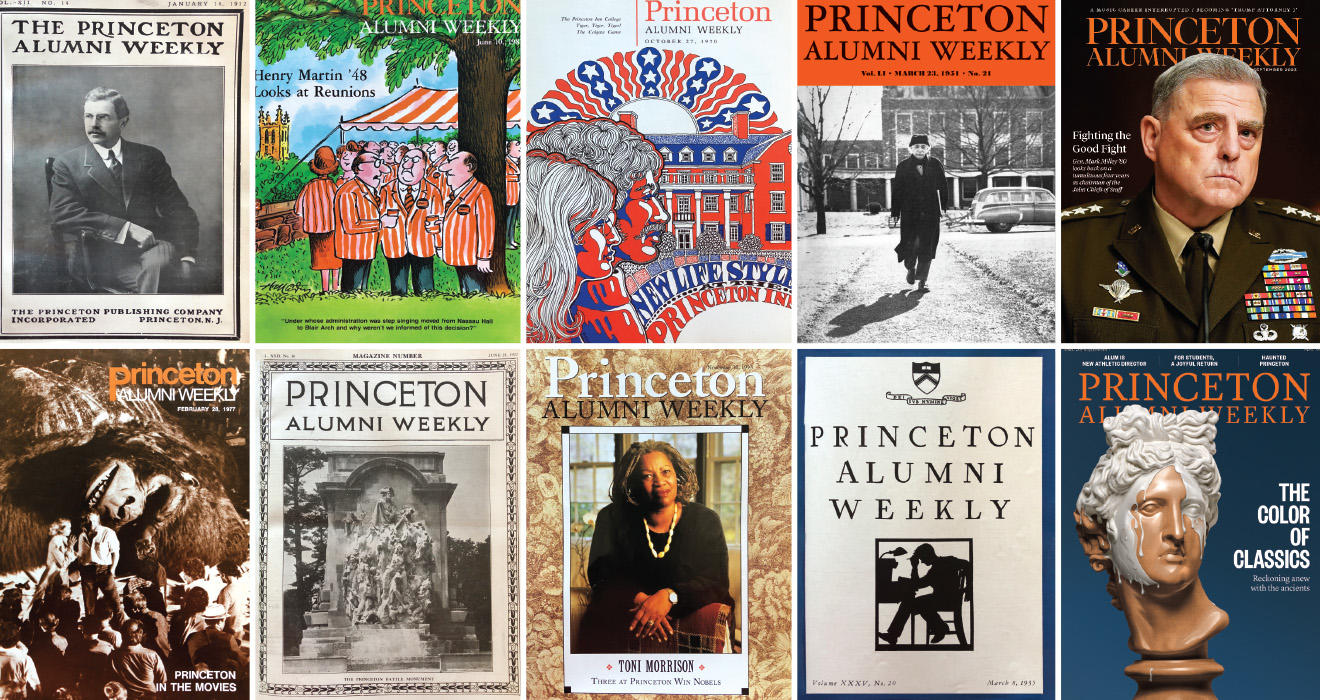
‘By Alumni, For Alumni’
PAW marks 125 years of chronicling campus life, alumni achievements, and historical events
The first issue of PAW was published 125 years ago on April 7, the collective effort of Frank L. Janeway 1901, John L. Rogers 1901, and editor Jesse Lynch Williams 1892.
From the outset, PAW has aimed to keep alumni connected and informed about University matters. As Williams noted in introducing the publication, “The abstract sentiment of affection for alma mater, being a matter of the heart, cannot well supply the head with actual facts.”
That guiding principle has endured for generations of Princetonians. Over the years, thousands of Princeton community members have contributed to PAW. In the 2023-24 academic year, more than 400 writers, photographers, illustrators, class secretaries, memorialists, student interns, contributors, and editors produced 11 print issues and fresh and newsy digital reporting on our website and in your email.
More than a publication for the community, PAW is by the community.
One of the privileges of being a PAW editor is working with such a diverse group of passionate people — especially class secretaries, who not only volunteer their time to fill the Class Notes pages but also serve as a vital link to readers, shaping the magazine’s heart and soul.
Marilyn Marks *86, who served as editor from 2002-22, put it like this: “I learned a lot from all of the people that we wrote about,” she says, “and to me, it was very important to write about not famous alumni, but alumni who aren’t covered in other publications, but are doing pretty amazing things. And talking to those people was really fascinating.”
As PAW marks its 125th anniversary, managing editor Brett Tomlinson has delved into the archives to uncover poignant, humorous, and insightful moments from the magazine’s history. From chronicling campus life and alumni achievements to historical events, you’ll see how PAW has changed with the times but continues to uphold its original mission. — By P.B.
On the Campus
What’s happening at Princeton? Ted Norris 1895, PAW’s longest-serving editor, looked to student writers to help answer that question in 1914 when he introduced “The Undergraduate Week” (a precursor to today’s Student Dispatch). The column aimed “to present the news and views of the campus from the undergraduate point of view.” Students, PAW staffers, and other contributing writers have been on the scene for some of Princeton’s most historic moments — and other events that might have escaped the eye of less attentive reporters.
PREPARING FOR WAR
March 7, 1917 – Henry T. Dunn 1917 writes about the gym’s transition from recreation to military training. “Overhead, instead of the indiscriminate shouts and yells and the usual clatter of feet in several games of basketball, you will hear the measured tread of marching squads and the occasional quick commands of the sergeants and corporals as they lead their men through the various formations.”
SHIVER ME TIMBERS
Oct. 31, 1923 – J. Branch Darby 1924, “the ‘Flo Ziegfeld’ of the Triangle Club, has issued a call for chorus girls and boys for the 1923 pirate show, and it seemed that half of the undergraduate body responded,” writes Alexander Leitch 1924. “Darby’s keen eye for grace and beauty cut this huge squad down to the conservative number of 140, who are now engaging in nightly workouts in the Gym.”
PARTY’S OVER
Sept. 25, 1931 – “For everybody’s good, even his own, the coon-skin-coated, hip-flasked, joy-riding type of undergraduate has disappeared,” writes Dean Christian Gauss, in a column titled “Boom Times Are Over.” The Great Depression, he argues, has encouraged students to recognize the value of a college education, and “many of them are making heroic sacrifices” to pursue their degrees, with uncertain job prospects ahead.
THE BELL TOLLS
May 18, 1945 – At noon on VE Day, May 8, “Dean Root started the Nassau Hall bell tolling and relays of undergraduates, trainees, administrative officers, and faculty pulled the rope for 45 minutes — until the start of afternoon classes.”
SITTERS FOR HIRE
Jan. 31, 1947 – “Phone us any time of day, we’ll have a sitter on the way.” That’s the slogan of the Tiger Tot Tending Agency, formed by enterprising undergrads to provide babysitters to the growing share of postwar students who are also young parents.
MEAL PLAN
Oct. 16, 1953 – The Graduate College, which dropped its requirement of wearing academic gowns at dinner during World War II, brings it back a decade later. “The decision to return to the wearing of gowns during the evening meal has raised a storm,” PAW reports. “The two-to-one vote of the graduate students against reviving the tradition was ignored by the powers that be … [and] a non-conforming segment of the graduate students is eating dinner in the refectory in protest against the pronunciamento.”
BEAT YALE
Dec. 1, 1961 – “All week long the controversy raged: exactly what degree of animosity towards Yale was it permissible to exhibit in polite society?” writes student columnist Frank Deford ’61. “The more heated segment — including The Daily Princetonian — felt that anything less than ‘hate’ was practically treasonous, while the more moderate — backed up by Security Officer Walter Dodwell and his proctors — suggested that frustrations could be satisfied with nothing more than entreaties to ‘beat.’”
INTOLERABLE
Dec. 5, 1967 – John V.H. Dippel ’68 interviews Professor Gardner Patterson, chair of the committee studying coeducation at Princeton. “Patterson must take account of two polarized viewpoints on coeducation. One side asks: ‘Is it tolerable for Princeton University, as a university of high caliber, to deny access because of sex?’ while the other poses: ‘Doesn’t society need at least one university that is all-male?’”
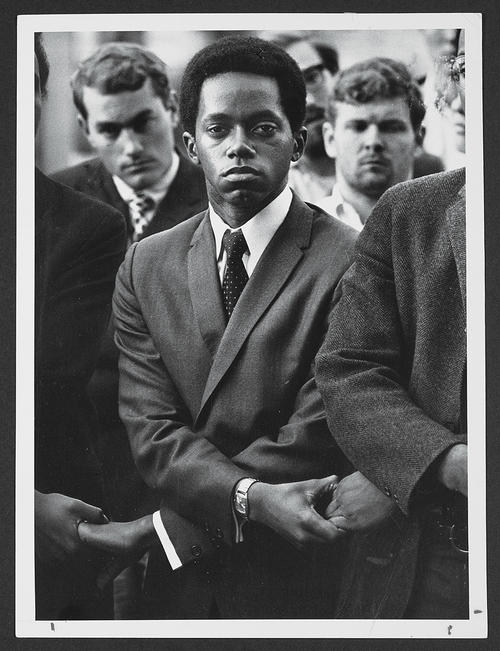
MORE THAN A MOMENT
April 23, 1968 – While other colleges were canceling classes for Martin Luther King Jr.’s funeral, Princeton suggested “a moment of silent meditation,” John V.H. Dippel ’68 reports. “But when some 30 members of the undergraduate Princeton Association of Black Collegians (ABC) met with President Robert Goheen [’40 *48] just before midnight on the porch of his residence, Walter Lowrie House, President Goheen agreed to officially suspend classes.”
STRIKE AGAINST THE WAR
May 19, 1970 – President Richard Nixon’s April 30 speech defending American military action in Cambodia sparks campus protests. In the Chapel, “one half-hour after Nixon’s final ‘good night,’ some 2,500 students and faculty members had congregated with an angry, if yet ill-defined determination to force a change of course in this new war,” writes Peter G. Brown ’70. Students call for a strike against the war, leading to the cancellation of classes and exams.
‘THE FEMALE GHETTO’
May 29, 1973 – “Princeton did not become a truly coeducational campus until our sophomore year when the female ghetto in Pyne Hall was disbanded,” writes graduating senior Jane Leifer ’73 in an essay about what’s changed (and what hasn’t) during her four years.
NAKED TRUTH
Feb. 8, 1982 – “Like all true traditions, nobody knows when the first Nude Olympics were held, not counting those in ancient Greece,” writes Todd A. Frederickson ’83. “Unlike most traditions, the Nude Olympics have no organization whatsoever. Partly because they rely on weather, and partly because it would make them less fun, nobody plans anything; they just happen.”
‘FIRST DAY OF NOBELITY’
Nov. 10, 1993 – Professor Toni Morrison “seems determined not to let the Nobel Prize greatly change her life,” PAW reports. “‘Chaotic and disruptive,’ she describes Oct. 7, her first day of Nobelity, ‘but in the best way, because all of the interruptions are congratulatory and the chaos comes out of a great deal of happiness.’ … At the end of the day, friends gathered at President [Harold] Shapiro’s residence to fete her. Then she quickly rededicated herself to the teaching and writing that Princeton’s tranquility makes possible.”
IN HINDSIGHT
Feb. 25, 1998 – “If you read the latest reports in the media, computers and the Internet are supposed to be revolutionizing education by increasing the amount of information available to today’s students,” writes Wes Tooke ’98. “Let me nip that in the bud. There is nothing less useful for research than the Internet as it exists today.”
RACIAL RECKONING
Jan. 13, 2016 – “A student sit-in Nov. 18 ended after 33 hours, but the issues it raised — relating to Princeton’s racial climate, the role of history, and the legacy of a man long seen as a Princeton hero — remained after the protesters walked out of Nassau Hall,” reports PAW’s Allie Wenner, adding that administrators “made no commitments about how the best-known of the demands — removing the name of Woodrow Wilson 1879 from University buildings and programs — would be resolved.”
Sports
Alumni devotion to Princeton athletics was apparent from PAW’s early days: Baseball line scores appeared in the magazine’s third issue, and a track and field report from the Penn Relays ran the next week. By the fall, full pages were set aside for detailed accounts of the
football games.
PAW also covered the rapid rise of women’s athletics in the 1970s. “Originally I had a five-year plan for women’s athletics: design a good physical education program, build toward intramurals, and then phase into intercollegiate competition,” associate athletics director Merrily Dean Baker explained to Dan White ’65 in 1973. “That metamorphosis took three weeks.”
HOOP DREAMS
Jan. 12, 1901 – “The undergraduates are talking of introducing basketball at Princeton and establishing a University team, and permission has been obtained to practice the game in the gymnasium.”
WELCOME TO JUNGLETOWN
Nov. 22, 1935 – “According to Asa S. Bushnell ’21, graduate manager of athletics, one-fifth of all the alumni return to Jungletown for each major football battle. He predicts that the football crowds this fall will break all former attendance records.” The Tigers finished the year 9-0.
Z IS FOR ZAMBONI
March 6, 1959 – Describing a cover photo of Princeton’s first Zamboni, PAW writes, “This strange new animal, looking like something out of James Thurber’s medieval bestiaries with its glaring eyes and mystic symbol ‘Z,’ might be interpreted as a symbol of a rink renaissance.” It cleans and resurfaces the Baker Rink ice in 10 minutes, four times faster than doing the job by hand.
‘NOT SLOW’
May 8, 1996 – “For eight straight seasons, and 14 of the past 21, Princeton has held opponents to fewer points than any other team in the nation,” writes Alexander Wolff ’79 in a portrait of retiring men’s basketball coach Pete Carril. “The Tigers’ dominance in this category has given rise to the accusation that their defense doesn’t so much deserve credit as their offense deserves blame. … Did someone call Princeton’s offense slow? ‘Not slow,’ Carril says. ‘Judicious.’”
Research
Princeton has been home to dozens of Nobel laureates and distinguished innovators across a broad range of academic disciplines, and throughout its history, PAW has aimed to keep readers informed about their work.
EINSTEIN’S LECTURES
May 18, 1921 – Following Albert Einstein’s lecture series on campus — part of his first visit to the United States — PAW writes, “The visit of the eminent physicist, the most conspicuous figure in the modern scientific world, has of course been the great intellectual event of the year, or for that matter many years.” The lectures are later published as a book, The Meaning of Relativity.
JOHNNY ON THE SPOT
May 2, 1930 – “Eventually men will travel to the moon,” physicist John Q. Stewart 1915 writes, “but not until they can construct rocket-driven ‘ships’ capable of driving through empty space at speeds above 10,000 miles an hour.” Stewart also envisions the landing party communicating with Earth “by telephoning over a beam of light.”
SUMMER IN THE FIELD
Oct. 4, 1957 – “Professor Harry H. Hess [*32], chairman of the Department of Geology, traveled to Puerto Rico, Venezuela, the Dominican Republic, and the Virgin Islands to continue his studies of the formation and development of mountains and the relation of earthquakes and volcanic eruptions to the process. … He has spent the past 12 summers on the project.”
INVESTING IN FUSION
Nov. 21, 1971 – “Construction of what scientists hope will be the world’s first magnetic confinement device capable of producing a significant amount of fusion energy began at the University’s Forrestal Campus. The $239-million project, called the Tokamak Fusion Test Reactor, is being funded by the U.S. Department of Energy and carried out by Princeton’s Plasma Physics Laboratory.”
‘GENETIC REPORT CARDS’
Feb. 23, 2000 – The Human Genome Project “will radically change the practice of medicine,” Professor Shirley M. Tilghman, director of Princeton’s new Institute for Integrative Genomics, tells PAW’s Katherine Federici Greenwood. Tilghman predicts that in the future, individuals could be given “genetic report cards” at birth that tell them what diseases they are susceptible to and allow them to act accordingly.
Princetonians
While PAW profiles alumni, from Supreme Court justices to public defenders, billionaire CEOs to small-business owners, the magazine also tells stories of alumni joining together to celebrate their common bonds — at Reunions and in smaller groups.
GRAND OCCASION
Feb, 23, 1912 — Alumni gather inside the Waldorf Grand Ball Room in New York City to celebrate the election of John Grier Hibben 1882 as the 14th president of Princeton. At the time, there were 6,400 alumni, and 1,100 attended the event, including members from the classes of 1851 through 1911. Were wives and girlfriends invited? Yes. “The boxes surrounding the Grand Ball Room were filled with ladies,” PAW reported.
WILSON’S WIN
Nov. 6, 1912 – Woodrow Wilson 1879 wins the presidency, becoming the first alumnus since James Madison 1771 to attain the nation’s highest office. “President Hibben ordered the bell rung and the national flag raised on Nassau Hall, suspended the exercises of the University, and made Wednesday a holiday … .”
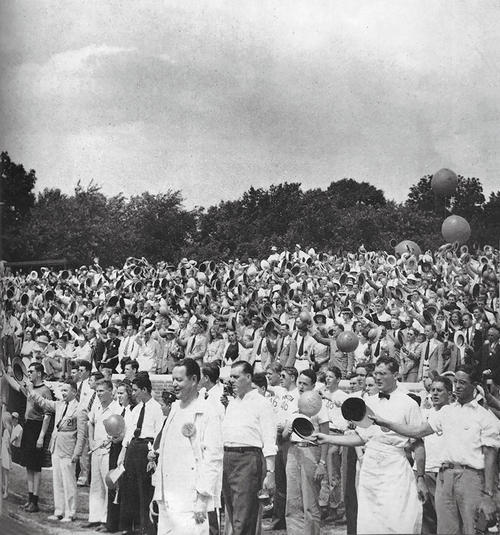
VICTORY REUNION
July 19, 1946 – Reunions returns after its World War II hiatus, bringing a record crowd back to Old Nassau. “The Victory Reunion is over, but the closer bonds it forged between Princeton and its loyal alumni body remain. … The official count on alumni attendance was 7,300, short of the [10,000] figure anticipated in some quarters but nonetheless nearly twice as large as in any previous year.”
FIRST ALUMNA
July 5, 1966 – The number of Ph.D.s awarded at Commencement climbs to 222, topping the previous high of 192. “Significant in that group, too, was Mrs. Sabra Follett Meservey [*66], the first formally enrolled woman candidate for a higher degree here.”
MAN ON THE MOON
Dec. 2, 1969 – Introducing a special issue on Princeton in Space: “Though Princeton’s effort in this field has been continuing for 20 years, it never seemed quite so real as when Pete Conrad ’53 stepped out onto the moon. With tons of scientific gear, incidentally, Commander Conrad took along several silk Princeton flags, manufactured especially for the occasion by C. Douglas Hardy [1925].”
IT’S ONLY HUMAN
March 23, 1988 – Librarian of Congress James Billington ’50, in an essay about the role of the humanities, writes that humanists “are the investigative reporters of humanity’s messy intermediate region, which lies somewhere between the mystery of the supernatural and the mastery of the natural. Humanistic scholars are part of a great chain — not of being but of becoming.”
PLAY BALL!
May 10, 1995 – “Talk about Princeton in the nation’s service,” writes Robin L. Michaelson ’89. “On March 31, Sonia Sotomayor ’76, a federal judge on the United States District Court in Manhattan, issued an injunction against the owners of major-league baseball teams, enjoining them from unilaterally imposing contract terms to govern the 1995 baseball season. Thanks to this ruling, the players ended their strike, the owners accepted the players’ offer to return to work, and ‘America’s pastime’ is underway again, after a painful, 234-day hiatus.”
AMAZED BY AMAZON
April 19, 2000 – Jeff Bezos ’86, “the grand eminence of e-commerce … seems an unlikely revolutionary,” writes Dan White ’65. “But his whirlwind enthusiasm in bringing a fanciful notion to (virtual) reality has done nothing less than revolutionize the way America — and the world — does business.”
9/11 FALLOUT
Oct. 10, 2001 – Within hours of the 9/11 attacks, PAW writes, “nearly 100 people had posted messages to the career-networking list offering their homes to anyone stranded, according to list coordinator Terry Wintroub ’69. Alumni also posted messages to princeton-matters regarding each others’ safety, and one alumnus, Scott Rafferty ’76 *79, painstakingly compiled a list of Princetonians with work addresses in the Pentagon and World Trade Center and e-mailed each one.” The 14 alumni who died in the attacks would later be memorialized in a garden next to Chancellor Green.
Inbox
“Every member of the collegiate family has the right to criticize the family paper,” PAW’s editors write in January 1901, nine months after the magazine’s founding. Alumni set to work turning that practice into a tradition, opining on topics that have endured for more than a century (tuition and financial aid, behavior of the undergrads, the role of the trustees, and the balance between athletics and academics).
Today, more than 100 letters appear in print each year, and 300 to 400 more online. Printed letters are capped at 250 words, which may seem stingy to some impassioned readers, but the hope is to include a wide range of views. As David G. McAneny ’41 helpfully noted in a 1989 letter to PAW, Lincoln managed to compose the Gettysburg Address with 268 words. Here are nine memorable lines from alumni letters published in the magazine.
“I have always understood the parade was an Alumni Parade, and as Princeton has never been coeducational, I fail to see the significance in the ladies participating.”
— Anonymous letter attributed to an “Old Guardsman,” reacting to the presence of “wives, sweethearts, and sisters” in the 1914 P-rade. (June 17, 1914)
“The two big failings of the present-day reunion are the expense, and the low moral tone of the whole affair.”
— A.H. Berry 1909, who bemoaned the flow of liquor under Reunions tents during Prohibition. (April 15, 1925)
“What is wrong with our song writers of more recent decades! It is time for them to get busy.”
— Kenneth S. Clark 1905, composer of “Going Back to Nassau Hall,” on the lack of new songs at football games. (Nov. 14, 1930)
“The fact that it is to be of Gothic design does not mean that students will have to play squash in dungeons or basketball on old flagstones.”
— John M. Kauffmann ’45, responding to alumni complaints about the plans for Dillon Gymnasium. (Nov. 16, 1945)
“Evidently advancing years bring higher blood pressure and a lower boiling point.”
— Lawrence C. Woods Jr. 1922, jousting with readers who objected to PAW’s story about his classmate Adlai Stevenson 1922. (Jan. 18, 1957)
“How can anyone prefer this monstrous, gaping hulk to the inspiring, soaring towers of English Gothic?”
— C.J. Repka ’31, on the construction of New South. (Oct. 4, 1966)
“For my part, I think it’s all a tempest in a peepot.”
— Francis M. Ellis ’45, replying to a graduate student’s letter about public urination on Prospect Avenue. (June 15, 1988)
“Disgusting, revolting, indecent, nauseating, upsetting, appalling.”
— Henry L. Miller ’34, referring to a column on the Nude Olympics. He suggested arresting the streakers next year. (April 15, 1992)
“Get over it, guys — and try joining the human[e] race.”
— Jensine Andresen ’86, in one of many responses to an alumnus’ letter urging Princeton to become “a single-sex, female university,” now that its president, provost, and PAW’s editor were all women. (March 13, 2002)
Memorials
Early memorials in PAW often were signed by several classmates and took the form of resolutions — lists of proclamations leading with “Whereas.” The current practice of designating a memorialist for each class evolved over time.
The oldest Princetonian to have his memorial published in the magazine is Samuel H. Pennington, Class of 1825, who died in 1900 at age 93. Pennington, a doctor in Newark, New Jersey, was a longtime University trustee who, according to the memorial, never missed a meeting until his health began to fail in his early 90s.
Class Notes
With the Alumni, Class News, Class Notes — the space devoted to classes has had several names and, even in the age of social media, remains a popular starting point for readers retrieving their magazines from the mailbox (or email inbox).
Few graduates can match the escapades of J.D. Oznot ’68, the only fictional alumnus who was actually admitted to Princeton. Oznot pops in at Reunions and class dinners, often appearing in group photos (off to the side, facing away from the camera). Whether freelancing as a political consultant, opening a detective agency, parasailing in the Great Salt Lake, or reeling in a giant trout in New Mexico, he always seems to be trying something new. He’s run for public office (and lost, despite voting for himself 68 times). His second wife, Dorothy, gave birth to triplets in Emerald City, Kansas, shortly before the class’s Wizard of Oz-themed 25th reunion. And in 2022, he dipped a toe into the burgeoning world of cryptocurrency. But the quintessential Oznot report appears in PAW’s May 13, 1975, issue:
“I think everybody will breathe a huge sigh of relief when they hear the news that Joseph Oznot was, after all, not involved in the Watergate affair,” class secretary Gerald Yukevich ’68 writes. “I had lunch with Joe recently at Durgin Park and he told me he has been keeping literally a low profile, doing some underwater exploration for Hughes Aircraft near Hawaii. He still has plans to set up a nation-wide chain of tattoo parlors under the name of Tiger Cat Tattoos. Joe said he’ll be at Reunions wearing some of his finest.”
— Compiled by PAW managing editor Brett Tomlinson.

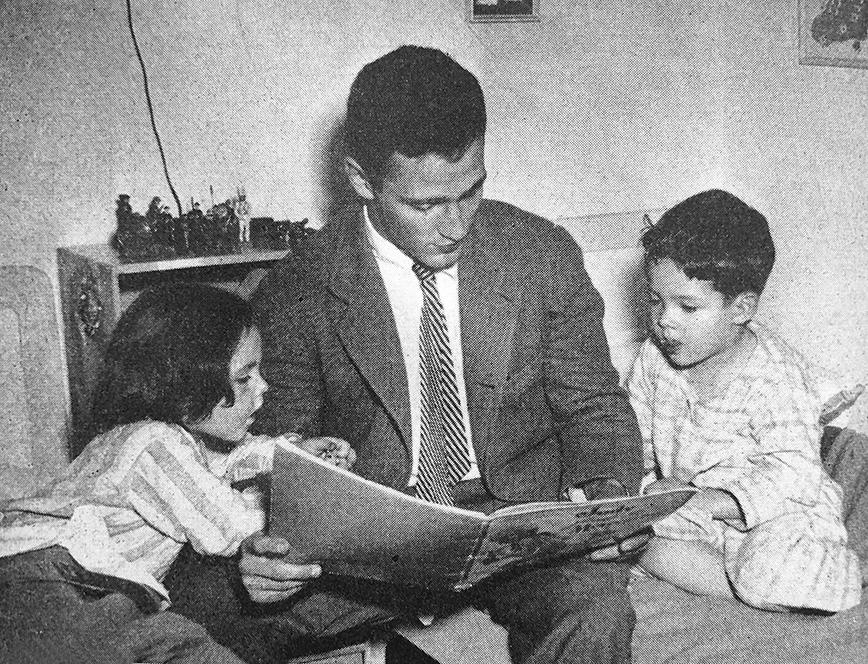
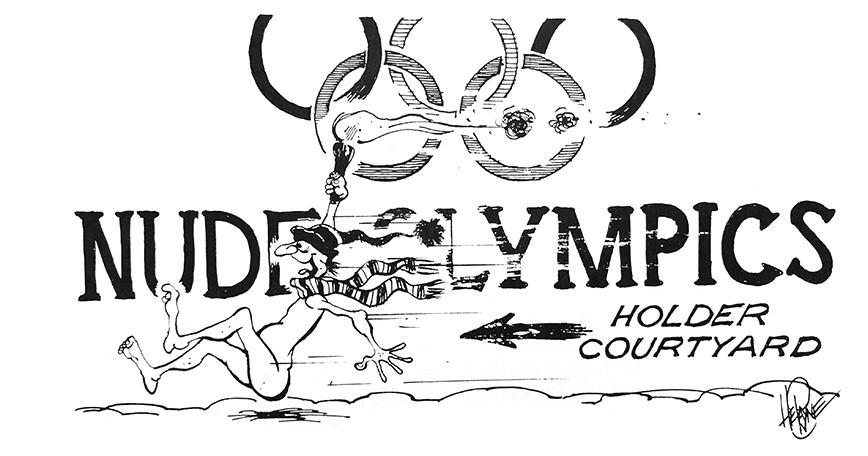

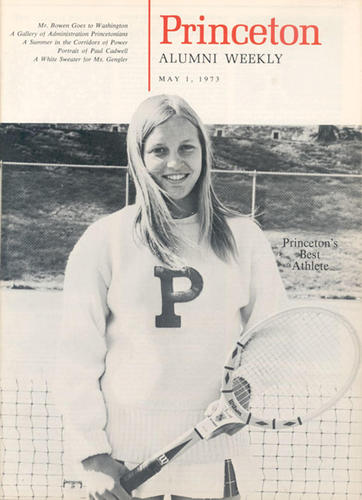
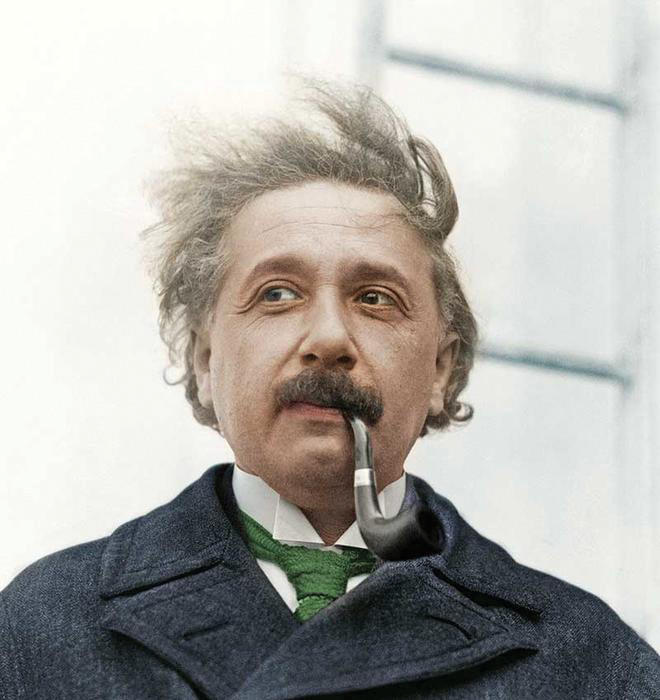
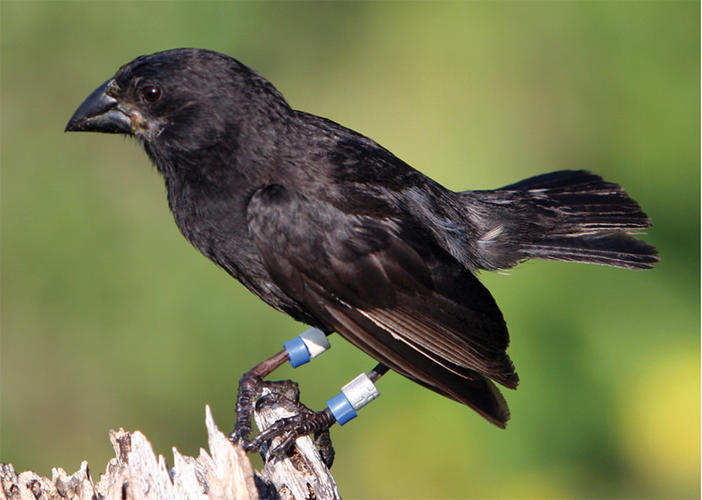



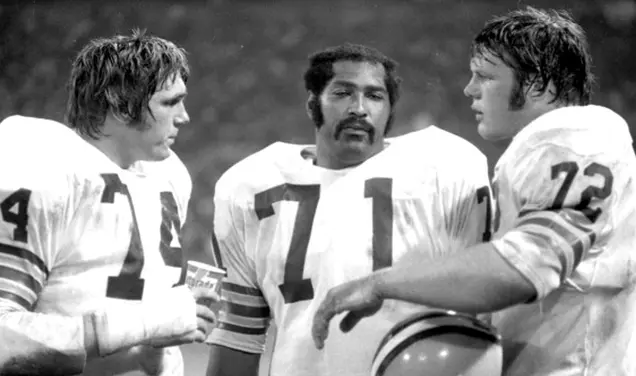

3 Responses
Charlie Henkin ’64
7 Months AgoIn Praise of Alumni Ties
Scanning the latest PAW, I thought back to my coffee with Rag Osborn 1907, the founder of the Princeton Band and composer of several major school songs still sung today. Mr. Osborn died in 1965 or ’66 (the obit histories differ) around age 80. His practice in the early ’60s (at least) was to have a coffee with the incoming Band president. In my case this would have been sometime in my 1963-64 tenure, probably early on during 1963 concert band season. I still recall this old gentleman (I am now older than he was at the time) touching base with the organization he founded. He would have graduated about seven years after PAW was founded.
His mind was sharp, although he seemed physically older than a 78-year-old man might today. He recounted a story of the composition of one of his songs. But I was impressed with his spirit and commitment to the school and the Band.
Bob Peskin ’78
8 Months AgoOur Tiger Tot Tender
I was delighted to see a photo of one of the Tiger Tot Tenders in the April 2025 issue. While the student agency might have initially been intended to provide childcare assistance for Princeton students with young families, by the mid ’50s its clients included families like mine, who had no connection to the University.
Our beloved Tot Tender was Peter Gall ’58, with whom we stayed in touch for the rest of his life, even attending his 1961 wedding at the U.S. Army base in Germany where he was stationed. (We had recently moved to Geneva, Switzerland, and drove up for the celebration.)
In the attached photos, the black and white one is how we looked when Peter cared for us. In the color photo, taken a few years before his passing, Peter is seated next to his wife, Pali. I’m in the white shirt, next to my siblings Jim (Hamilton ’74), Sarah (Smith ’71), and Dick (Hamilton ’67).
Photos courtesy of Bob Peskin ’78
Fred Waage ’65 *71
8 Months AgoAnother Sobering Moment in 1968
With respect to “More than a Moment” in the fascinating “By Alumni, For Alumni” historical perspective (April issue): On June 8 of 1968, while Robert Kennedy’s funeral train was passing through Princeton Junction on its way to Arlington National Cemetery in Washington and alumni were getting wasted in their class tents, my wife of the time and I encountered Dean Ernest Gordon on campus bemusedly observing the festivities and suggested that the more appropriate response would be a remembrance service in the Chapel. He agreed, and it was held, a very uplifting moment in a time of chaos, an act similar to the class suspension after MLK’s assassination, described in the PAW account. We are now living through desperate times for our country and the world. Will we party on?